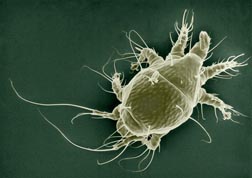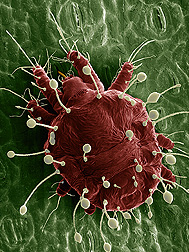|
Post by: Brian Lovett and Andrew Garavito One Giant Leap for Mitekind When it comes down to it, scientists are not limited by their imaginations; they are limited by their tools of observation. Since the dawn of the scientific method, scientists have been in an arms race to invent finer, more advanced tools to probe the world around them. If we want to see distant galaxies more clearly, we send a telescope into space. If we want to discover elementary particles, we collaborate and build the world’s largest particle accelerator. What if we wanted to understand the morphology, behavior and phylogenetics of mites? Enter Dr. Ron “Oh My Goodness” Ochoa. He literally added another dimension to acarology (the study of mites). Before his ingeniously elegant application of Low Temperature Scanning Electron Microscope (LT-SEM) techniques to his field, mite researchers were busily removing microscopic mites from their natural setting and flattening them between two pieces of glass. By limiting their field to two dimensions, acarologists (those scientists who study mites) were left with ambiguous morphological traits for identification and almost no information on how the mites behaved naturally. Once Dr. Ochoa poured liquid nitrogen on the field of acarology, everything changed. Adapting techniques developed to count snowflakes (thank NASA for funding that study), Dr. Ochoa created beautiful, observable frozen landscapes of mites in their natural habitats, which are not only three dimensional, but also well-preserved. Stored in liquid nitrogen, Dr. Ochoa’s samples remain preserved to answer questions that scientists have today or may have thousands of years in the future. Armed with a Hitachi 4700LT-SEM, Dr. Ochoa tries to understand how the mites contribute to the ecosystem. As the only arthropod present in every ecosystem on our planet, they have serious potential to make an impact. Dr. Ochoa’s research is driven by the images he takes with his LT-SEM, which grant him the first glimpses of the vibrant microscopic community we step over every day. The word exciting doesn’t begin to explain the Leeuwenhoekian wonder Dr. Ochoa feels as the first human to see a mite mother protecting and feeding her children, to watch a mite feeding through the stomata of a plant, or, in a James Bond inspired epiphany, to understand the cryptic spiny projections of the female mites with a penchant for honey bee trachea. His research grants him ample opportunities to exclaim his notorious catch-phrase “oh my goodness.” With a curiosity that surpasses the names he gives the mites he discovers (Dr. Ochoa confesses that entomologists have stolen all of the good names for invertebrates), his research interests are seemingly boundless. During his entomology department seminar, Dr. Ochoa reminds the audience that it is hypothesized that every beetle, moth, ant, plant, animal and soil has a mite that is associated with it. At this very moment, these ambitious invertebrates are crawling all over you. They have accompanied us in our every accomplishment: riding along through collapses of civilizations and even into space. In his presentation, he dared molecular geneticists to match the resolution his techniques have on mite phylogeny and behavior, with newer 3D modeling techniques on his immediate horizon. Dr. Ochoa has, without a doubt, revolutionized acarology by taking and analyzing images that are as moving as they are pervasive: showing up on airline magazines and in advertisements worldwide. In the lab with Dr. Ochoa, one small pour of liquid nitrogen turned out to be one giant leap for our understanding of mitekind. Read more about his research and the methods used to take some of these amazing photographs here: Use of Low-Temperature Field Emission Scanning Electron Microscopy to Examine Mites About Brian and Andrew:
Brian Lovett is a PhD student studying mycology and genetics in agricultural and vector biology systems. He is currently working on projects analyzing mycorrhizal interactions in agricultural systems and the transcriptomics of malaria vector mosquitoes. Andrew Garavito is a first year Master’s student in Dennis vanEngelsdorp’s Lab. He is studying honey bees; with a focus on the diversity of pollen types brought in by foragers, and the health effects of different pollen diets. Comments are closed.
|
Categories
All
Archives
June 2024
|
Department of Entomology
University of Maryland
4112 Plant Sciences Building
College Park, MD 20742-4454
USA
Telephone: 301.405.3911
Fax: 301.314.9290
University of Maryland
4112 Plant Sciences Building
College Park, MD 20742-4454
USA
Telephone: 301.405.3911
Fax: 301.314.9290



 RSS Feed
RSS Feed




